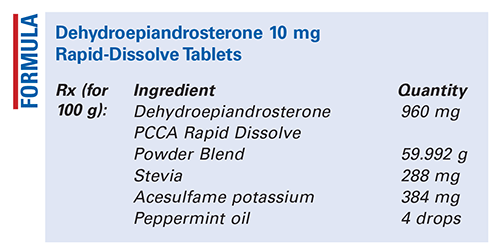US Pharm. 2022;47(6):58-59.

Method of Preparation: Note—with a 96-count (i.e., cavity) Professional Compounding Centers of America (PCCA) mold, each tablet should weigh 61.6 mg. Calculate the required quantity of each ingredient for the total amount to be prepared. Accurately weigh or measure each ingredient. Mix all of the powdered ingredients together until uniform. Geometrically, incorporate the peppermint oil; mix well. Press the powder evenly into the cavities of the rapid-dissolve tablet mold. Heat the cavity-filled mold in a convection oven at 100°C for 30 minutes. Cool the mold to room temperature and release the tablets from the mold. Allow the tablets to cool for an additional 30 minutes; then place them into blister packs for dispensing. Package and label.
Use: Dehydroepiandrosterone (DHEA) has been used to treat a number of different hormone-related disorders.
Packaging: Package in tight, light-resistant containers, preferably blister packs.
Labeling: Dissolve under the tongue. Keep out of reach of children. Discard after ____ [time period]. Protect from light and moisture.
Stability: A beyond-use date of up to 6 months may be used for this preparation.1,2
Quality Control: Quality-control assessment can include weight–overall average weight, weight–individual weight variation, dissolution, active drug assay, physical appearance, color, uniformity, and physical stability (discoloration or other changes).3,4
Discussion: DHEA (dehydroandrosterone, prasterone, C19H28O2, MW 288.42) is a major secretory product of the adrenal gland that decreases with age (estimated to decrease by up to 80% throughout adulthood). It may have estrogen-like or androgen-like effects depending on the hormonal milieu. When DHEA is taken as a supplement, some of it is converted into testosterone and estrogen. DHEA is believed to reduce total cholesterol; improve well-being, sexual satisfaction, and insulin sensitivity; and prevent bone loss.5,6 DHEA has been used to treat depression, osteoporosis, and vaginal atrophy as well as to decrease body fat and correct some hormonal problems.
Rapid Dissolve Powder Blend (PCCA) occurs as an white to off-white powder that may have a mild fat odor. Its melting point is between 135°C and 165°C. It is soluble in water and slightly soluble in acetone and alcohol.
Stevia (stevioside, honey leaf, yerba dulce) is a natural, nontoxic, and safe sweetening agent that is extracted from the leaves of the Stevia rebaudiana Bertoni plant. It occurs as a white, crystalline, hygroscopic powder that is about 300 times as sweet as sucrose. Stevia is commonly used in foods, and it may be used in both hot and cold preparations.7
Acesulfame potassium (Ace-K, C4H4NO4SK, MW 201.24) occurs as a white, crystalline powder or colorless crystals. It is soluble in water and very slightly soluble in alcohol. Ace-K is a calorie-free sugar substitute that used as a sweetening agent.8
Peppermint oil is a volatile oil distilled with steam from the fresh overground parts of Mentha piperita. It contains not less than 50% menthol and 5% of esters, namely menthyl acetate. It occurs as a colorless or pale-yellow liquid with a strong, penetrating odor of peppermint and a pungent taste followed by a sensation of cold when air is drawn into the mouth. It is soluble 1 volume in 3 volumes of 70% alcohol, and its specific gravity is 0.896 to 0.908. Peppermint oil is used as a flavoring agent, antiseptic, carminative, and local anesthetic.9
REFERENCES
1. U.S. Pharmacopeia/National Formulary [current revision]. Rockville, MD: U.S. Pharmacopeial Convention, Inc; May 2022.
2. Rush SD, Vernak C, Zhao F. A pilot stability study of dehydroepiandrosterone rapid-dissolving tablets prepared by extemporaneous compounding. IJPC. 2017;21(1):83-87.
3. Allen LV Jr. Summary of quality-control testing for sterile and nonsterile compounded preparations,part 1: physical and chemical testing. IJPC. 2019;23(3):211-216.
4. Allen LV Jr. Summary of quality-control testing for sterile and nonsterile compounded preparations, part 2: microbiological testing. IJPC. 2019;23(4):299-303.
5. O’Neil MJ, ed. The Merck Index. 14th ed. Whitehouse Station, NJ: Merck & Co, Inc; 2006: 2870.
6. Rutkowski K, Sowa P, Rutkowska-Talipska J, et al. Dehydroepiandrosterone (DHEA): hypes and hopes. Drugs. 2014;74(11):1195-1207.
7. Brayfield A, ed. Martindale: The Complete Drug Reference. 38th ed. London, England: Pharmaceutical Press; 2014:2214.
8. Huo MR. Acesulfame potassium. In: Sheskey PJ, Hancock BC, Moss GP, Goldfarb DJ, eds. Handbook of Pharmaceutical Excipients. 9th ed. London, England: Pharmaceutical Press; 2020:63-65.
9. Reilly WJ Jr. Pharmaceutical necessities. In: Gerbino PP, ed. Remington: The Science and Practice of Pharmacy. 21st ed. Baltimore, MD: Lippincott Williams & Wilkins; 2006:1066.
The content contained in this article is for informational purposes only. The content is not intended to be a substitute for professional advice. Reliance on any information provided in this article is solely at your own risk.
To comment on this article, contact rdavidson@uspharmacist.com.





